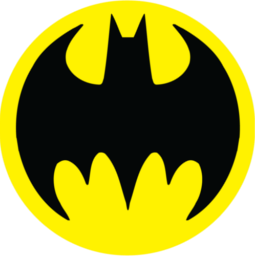No edit summary Tag: Source edit |
(Adding categories) |
||
| Line 118: | Line 118: | ||
[[Category:Batmobiles|1]] |
[[Category:Batmobiles|1]] |
||
[[Category:Vehicles]] |
[[Category:Vehicles]] |
||
| + | [[Category:Batman (1989 film) Objects]] |
||
| + | [[Category:Batman Returns Objects]] |
||
Revision as of 11:56, 3 May 2021
- "Get in the car!"
- ―Batman to Vicki Vale[src]
The Batmobile was Batman's primary mode of transportation. At first, Batman often simply referred to that Batmobile as "the car", and he later called it the Batmobile. The Batmobile was one of the most daunting components in Batman's vast arsenal, and he kept it stored in the Batcave when it was not in use.
History
Flugelheim Escape
Batman first used the Batmobile to rescue Vicki Vale from the Joker. After he parked it out front of the entrance Flugelheim Museum, Batman instructed Vicki to get into the vehicle as Joker's Joker Goons gave chase in their own cars. After it completely outmatched the Goons' and the GCPD for pure speed, the Batmobile was caught in a bottleneck, unfortunately. With the road blocked by a construction crew, Batman and Vicki abandoned the Batmobile and continued their escape. Eventually, Batman used a Communicator to call the Batmobile to him after he dispatched Joker's Goons.
Destroying Axis Chemicals
In an attempt to kill Joker after the recollection that he was responsible for his parents' deaths, Batman used the Batmobile to lay siege to Axis Chemicals and effectively demolished the complex despite Joker's escape in his helicopter.
Riot Control at Gotham Plaza
Three years later, Batman drove the Batmobile into battle against the Red Triangle Gang. When Gotham City's central Christmas presentation was disrupted by an assault by the Red Triangle Gang, Batman entered the fray with the Batmobile, and systematically used the car's arsenal of abilities to deter the criminals from causing further damage.
Tampering by the Red Triangle gang
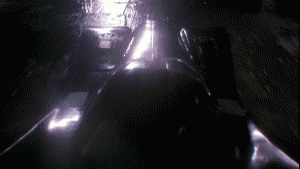
The Batmobile transforming into the Batmissile in Batman Returns
The Batmobile later became the target of a scheme by the Penguin to frame Batman as a criminal. After he sabotaged the Batmobile while Batman rescued the Ice Princess from Catwoman, Penguin gained control of the Batmobile, and used it in a destructive joyride throughout the civilian-filled Gotham streets before Batman managed to deactivate the receiver of the control signal. When the Batmobile was freed from Cobblepot's control, the incident caused the desired effect; and the public labeled Batman as a criminal. To narrowly escape from the GCPD, Batman was forced to eject the vehicle's side panels and transformed the Batmobile into the Batmissile. Bruce would later attempt to repair it.
Alternate Fates
According to several accounts, Batman would abandon attempting to repair the Batmobile in favor of replacing it. He would subsequently use two different models during his later adventures.
Technical Specifications
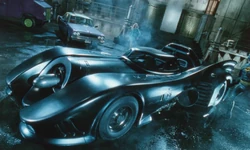
The Batmobile parked outside the Flugelheim Museum in Batman.
Statistics
- Length: 260.7 in
- Width: 94.4 in
- Height: 51.2 in
- Acceleration: 0-60 in 3.7 seconds
- Maximum Speed: 530 km/h with booster
- Engine: Jet Turbine
- Fuel: High octane; 97% special (gasoline paraffin mixture)
- Torque: 1750 lbf.ft at 98.7% ROS
- Wheelbase: 141.0 in
- Wheels: Cast alloy, 15 x 6.5
- Tires: High aspect L60-15
- Two-seat cockpit that featured aircraft-like instrumentation, a passenger's side monitor, self-diagnostics system, CD recorder, and voice-command operation and recognition system.
Arsenal
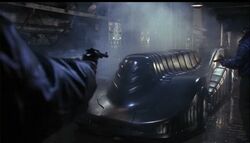
The Batmobile's Cocoon Mode at Axis Chemicals in Batman.
- Side-mounted grappling hook launchers, disc projectile launchers and bomb dispensers.
- Side chassis-mounted shin-breakers.
- A central "foot" underneath the vehicle that was capable of lifting the car and rotating it 180°.
- Armour plated body with an additional "Cocoon" of heavy armor capable of being deployed while vehicle was stationary (dubbed "Cocoon-mode").
- Rear oil slick dispensers and smoke emitters.
- Two forward mounted Browning M1919 .30 caliber machine guns.
- Exhaust after-burner.
- An emergency "Batmissile" mode that shed all material outside of the central fuselage and reconfigured the wheels and axles to fit through narrow openings. Once employed, the mode essentially destroyed the car's exterior, and required rebuilding afterwards.
- Only shown in the games, the Batmobile also featured forward mounted dual-missile launchers.
Appearances
Gallery
- See: Batmobile (Burtonverse)/Gallery for additional images
Behind the Scenes
Background Information and Notes
The original conceptual illustrations for this design were drafted by Julian Caldow, under direction from Tim Burton and Anton Furst. Caldow also designed the look of the "cocoon" shielding. Furst wanted Caldow to include jet aircraft components, war machines, and other such vehicles in their search to produce a car for an edgier, darker Batman than what was previously seen. In the end, and opting for pure expressionism, the production crew took design ques from the Salt Flat Racers of the 1930s and the Sting Ray macho machines of the 1950s to produce a veritable tank of a car. The body of the car was sculpted by Keith Short.
The scene in Batman of the Batmobile making its way to the Batcave was partially filmed using a radio controlled Batmobile model that was driven through a miniature forest road.
When Jay Ohrberg built the Six Flags versions of the Batmobile, he narrowed their rear quarters by about 4" on each side to allow the car to be transported easier as the width of the original Batmobile's hind quarters caused the wheels to hang over the side of a typical transport truck.
Legacy
Affectionately dubbed the "Keaton Mobile" after Michael Keaton; the actor who played Batman/Bruce Wayne in Batman and Batman Returns, the Batmobile's popularity with fans established a strong following. The Batmobile was used as a basis for several comic book cars (as well as itself made various cameos in the comics), as inspiration for the Batman: The Animated Series Batmobile, which served as a spokesmodel for OnStar in 1999, and easily ranked with the 1966 Batmobile as one of the most popular Batmobiles of all time.
The concept of the Batmobile shedding its shell to reveal a smaller escape vehicle was later used in The Dark Knight. After the Tumbler was catastrophically damaged by the Joker's rocket launcher, it folded and jettisoned the parts around its two front wheels into an escape vehicle called the Batpod.
Cameo and Guest Appearances
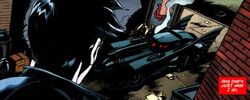
The Batmobile's cameo in Jason Todd: The Lost Days #2.
- A series of OnStar TV advertisements featured that particular Batmobile that was equipped with the system. That allowed Batman to call various Gotham characters, summon the GCPD, remotely unlock the vehicle's doors, and find the nearest jet fuel station.
- That version of the Batmobile was later seen in Lois & Clark: The New Adventures of Superman episode called "Don't Tug on Superman's Cape", an episode which showed that some collectors had apparently stolen the Batmobile.
- In the film, Looney Tunes: Back in Action, Daffy Duck drove the Batmobile into the water tower on the Warner Bros. Studio Lot, which caused it to fall over and nearly crush Jenna Elfman's character.
- On the TV series, Animaniacs, the Batmobile approached the WB studios front gates, and the guard at the door greeted the driver and said: "Good afternoon Mr. Keaton".
- In the second Animaniacs appearance featured a parody of the poem Twas the Night Before Christmas. As the WB studios emptied out for Christmas break, the Batmobile pulled up to the gate, and Ralph the Guard waved it through, and said: "Goodnight, Mr. Keaton, that's a lovely sedan".
- In the third Animaniacs appearance, Dot Warner's interpretation of a Puck soliloquy from A Midsummer Night's Dream rendered the line, "And Robin shall make amends ere long" as "And the Boy Wonder will save us". The Batmobile then drove up to the Warner siblings, opened its canopy, and Robin pulled the trio into the car, which then departed, and saved them from an angry fairy.
- In the "RPM" episode of the animated TV series, The Batman, one of Bruce Wayne's Batmobile prototypes was the Batmobile from the Burton Films.
- In the segment Working Through Pain episode of the animated flick Batman: Gotham Knight, Alfred used the Batmobile to pull the sewer gate to rescue Bruce Wayne, who was trapped underneath.
- The Batmobile made an appearance in the Tiny Toons episode, "The Return of Batduck", where Hamton J. Pig, as a parking attendant, tried to park the Batmobile while Batman (Michael Keaton) visited a restaurant that was attended to by Plucky Duck. In that episode, the Batmobile possessed a "Bat-Warp" drive and flew up to, and through, the moon.
- The Batmobile was set to appear as the primary Batmobile in the Batman Live - World Arena Tour in London.
- In Batman: The Animated Series, The Penguin sabotaged and took control of the show's Batmobile in a similar fashion to how he took control of the Batmobile in Batman Returns.
- In another episode of the show, while Poison Ivy and Harley Quinn escaped a museum heist together, Ivy ordered Harley: "Get in the car", to which Harley exclaimed: "Which car?". That was an allusion to a similar exchange between Batman and Vicki in Batman.
- The Burton-era Batmobile was seen in Batman: The Dark Knight Returns - Part 2 when Bruce Wayne (with the aid of his mechanical suit of armor) lifted it up to test his strength prior to his final showdown with Superman.
Trivia
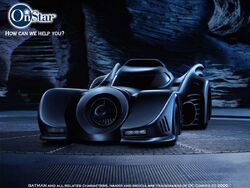
OnStar promotional image of the Batmobile.
- A Diet Coke commercial featured Batman driving the Batmobile on the way to the store to pick some up, while Alfred called the store and told them that a unique car was on its way to pick some up as they were down to their last Diet Coke.
- The Batmobile was built upon a Chevrolet Impala chasis with a Chevy V8 engine, and was based on and modified from a 1970 Corvette body when previous development with a Jaguar and Ford Mustang failed. A second car was based on an Oldsmobile Cutlass Convertible.
- All gadgets (aside from the cocoon-mode) on the Batmobile in both movies were fully functional, although the exhaust after-burner could only run for 15 seconds at a time due to the amount of fuel that it consumed.
- Initially, Batman's ears were too big to clear the roof when he entered the Batmobile and a modified cowl with shorter ears had to be made (as explained in the featurette, Building the Batmobile, from Batman: The Motion Picture Anthology).
- In addition to a new array of gadgets, the Batmobile in Batman Returns also possessed additional window-wipers that it did not have in Batman.
- The "Keaton-mobile" appeared in over 14 different video games that were associated with Batman and Batman Returns.
- For the scenes where the Batmobile deployed the cocoon armor in Batman, a life-size model of the vehicle was built and the animation was provided by stop motion technology. In Batman Returns, the shields had the same characteristics. However, the design was slimmer and the special effects were provided by computer-generated imagery.
- Replicas of the Tim Burton-era Batmobiles were on display in front of several Batman: The Ride roller coasters and also in the street near Batman Adventure – The Ride 2 at Warner Bros. Movie World.
- Historic auto attractions in Roscoe, Illinois displayed a replica of the Batmobile from Batman Returns as well as the "Batmissile" in addition to a replica of the Batmobile from the 1960s series.
